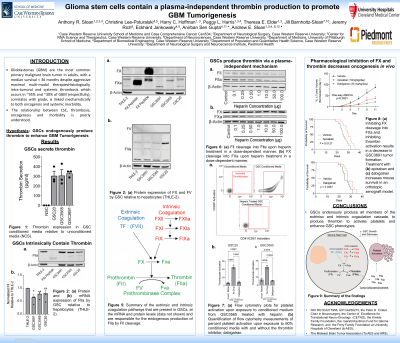Glioma Stem Cells Contain A Plasma-Idependent Thrombin Production to Promote GBM Tumorigenesis
Glioma Stem Cells Contain a Plasma-idependent Thrombin Production to Promote GBM Tumorigenesis
Friday, April 21, 2023


Andrew E. Sloan, MD, FAACS, FACS (he/him/his)
Chief of Neuroscience
Piedmont Health
Atlanta, Georgia, United States
ePoster Presenter(s)
Introduction: Glioblastomas (GBM) are the most common primary malignant brain tumor in adults, with a median survival < 36 months despite aggressive maximal multi-modal therapies. GBM are characterized histologically by a dense neovascular enhancing region associated with thrombosed vessels, a necrotic core, cytotoxic edema and infiltration of the surrounding brain. Mechanistically, gliomas are increasingly believed to be derived from glioma stem cells (GSCs). Histologically, intra-tumoral and systemic thrombosis occurs in ~95% and ~30% of GBM (respectfully), correlates with grade, and is linked mechanistically to both oncogensis and systemic morbidity. However, the relationships between GSC, thrombosis, oncogenesis and morbidity is poorly understood.
Methods: Immunofluorescence, qPCR, and Western blots were used to determine expression of coagulation factors in GBM tissue and subsequent GSC lines. Male and female NSG mice were transplanted with orthotopic, GBM-derived GSC lines and treated with anti-thrombin inhibitors.
Results: GSC endogenously produce all the coagulation factors of the intrinsic, extrinsic, and prothrombinase cascades, generating thrombin via a plasma independent mechanism, which they secrete into the tumor microenvironment. Thrombin secretion subsequently activates platelets in the absence of plasma (p < 0.05). Conversely, inhibiting GSCs thrombin production abrogates platelet activation (p < 0.05). Similarly, inhibiting intratumoral thrombin production and function slows tumor growth in vitro and in vitro (p < 0.002), and improves survival of mice with orthotopic human GBM-derived GSC xenografts (p < 0.05).
Conclusion : GSC endogenously produce all the coagulation factors of the intrinsic, extrinsic, and prothrombinase cascades, generating thrombin via a plasma-independent mechanism, which they secrete into the tumor microenvironment, activating platelets in the absence of plasma (p < 0.05). Conversely, inhibiting GSCs thrombin production abrogates platelet activation (p < 0.05). Similarly, inhibiting intratumoral thrombin production and function slows tumor growth in vitro, in vitro (p < 0.002); and improves survival of mice with orthotopic human GBM-derived GSC xenografts (p < 0.05).
Methods: Immunofluorescence, qPCR, and Western blots were used to determine expression of coagulation factors in GBM tissue and subsequent GSC lines. Male and female NSG mice were transplanted with orthotopic, GBM-derived GSC lines and treated with anti-thrombin inhibitors.
Results: GSC endogenously produce all the coagulation factors of the intrinsic, extrinsic, and prothrombinase cascades, generating thrombin via a plasma independent mechanism, which they secrete into the tumor microenvironment. Thrombin secretion subsequently activates platelets in the absence of plasma (p < 0.05). Conversely, inhibiting GSCs thrombin production abrogates platelet activation (p < 0.05). Similarly, inhibiting intratumoral thrombin production and function slows tumor growth in vitro and in vitro (p < 0.002), and improves survival of mice with orthotopic human GBM-derived GSC xenografts (p < 0.05).
Conclusion : GSC endogenously produce all the coagulation factors of the intrinsic, extrinsic, and prothrombinase cascades, generating thrombin via a plasma-independent mechanism, which they secrete into the tumor microenvironment, activating platelets in the absence of plasma (p < 0.05). Conversely, inhibiting GSCs thrombin production abrogates platelet activation (p < 0.05). Similarly, inhibiting intratumoral thrombin production and function slows tumor growth in vitro, in vitro (p < 0.002); and improves survival of mice with orthotopic human GBM-derived GSC xenografts (p < 0.05).
